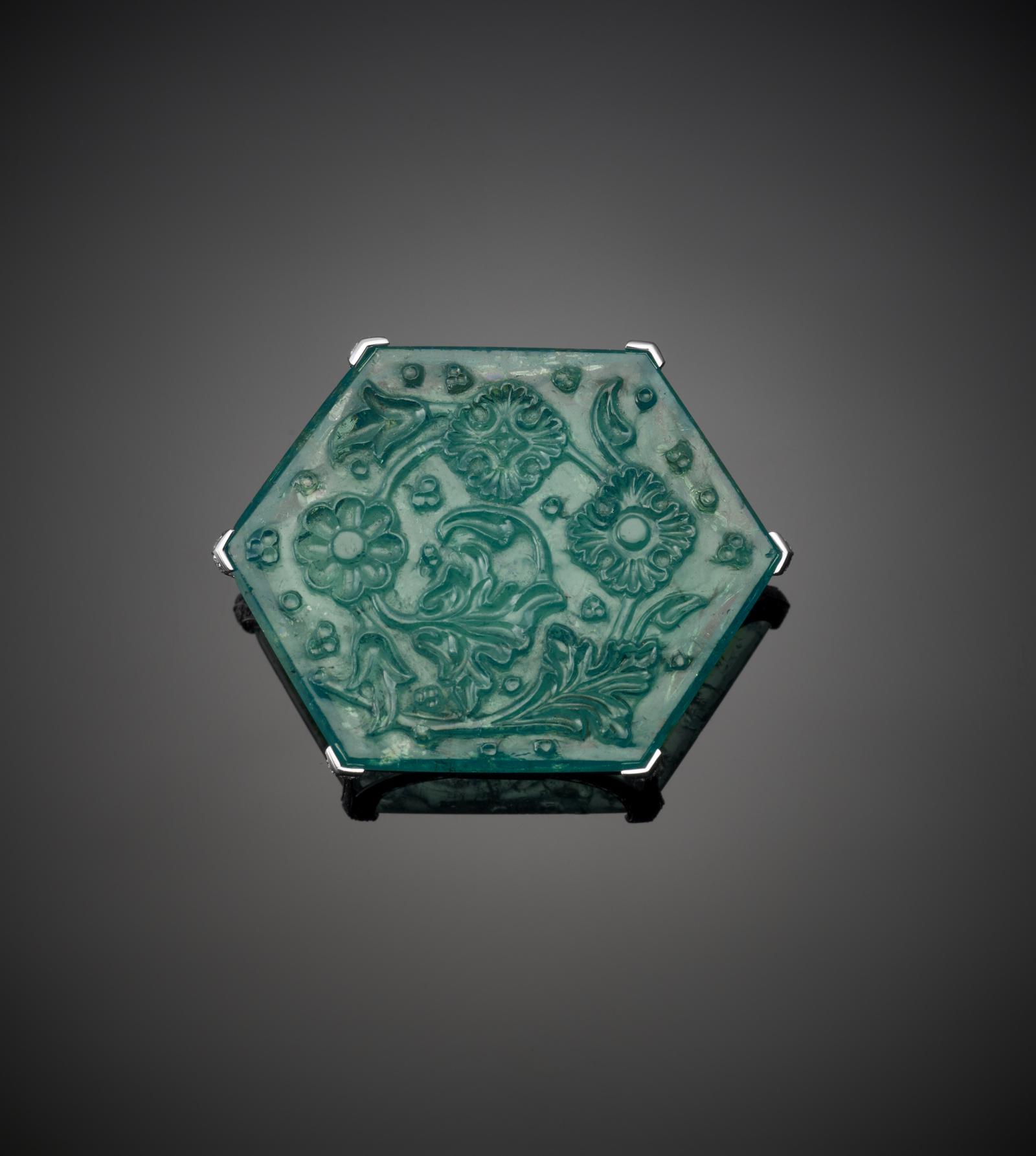
Treasures of Cartier at the Grand Palais
From March to July 2017, the Grand Palais will be hosting two new exhibitions – Jardins (Gardens) and From the Great Mughals to the Maharajas: Jewels from the Al Thani Collection.
To best demonstrate these themes, the exhibition curators called on several eminent institutions including the Cartier Collection, whose works were previously presented at the Galeries Nationales for the retrospective exhibition Cartier: Style and History in 2013–2014.
15 March – 24 July
Jardins (Gardens)
Jardins is an unusual meta-exploration that traces the art history of parks and gardens as well as the history of exhibitions on the same theme. Its broad-ranging approach encompasses paintings, sculptures, photographs, drawings, precious objects and installations that appeal to the senses, such as the sense of smell. The garden is de ned as a complete work of art, which poses the central question of its representation.
Curator Laurent Le Bon has selected 17 pieces from the Cartier Collection depicting a natural world that is figurative and lifelike yet not without poetry.
Flowers are part of the Cartier vocabulary and one of the jeweller’s most beloved themes. Floral creations inhabit this borderline between naturalism and poetic evocation.
Cartier has returned to this oral repertoire time and again since its inception and throughout its stylistic history. At the dawn of the 20th century the Belle Epoque saw the birth of the Garland style as a genre in its own right, fashioned from platinum and diamonds. In the 1920s lush, fertile depictions of the natural world blossomed into the Tutti Frutti style, which enhanced dazzling precious materials with contrasts and colour combinations. Colourful carved stones – sapphires, emeralds and rubies – conjured a fantasy of India.
In the 1930s, the Maison draws inspiration from lines and proportions. Jeanne Toussaint, who was appointed Creative Director in 1933, interpreted the oral repertoire to stunning effect with her highly original three-dimensional renderings. In 1941 Cartier executed a flower brooch with an entirely articulated stem that trembled when worn. The ower, depicted in profile with drooping petals, appears as if shaken by the wind or hanging heavy in the sunshine. This dramatic and surreal take on the natural world re-emerged in the 1970s when Cartier created a flower brooch with wooden petals and a gold pistil, in a bold juxtaposition of precious metal and raw material.
Cartier’s oral compositions harness the skilful craftsmanship of the Maison and technical prowess of each era, as seen in the richness and vitality of this creative vein. Flowers, foliage, oral arrangements, bouquets and palm fronds – that are part of the Cartier vocabulary – celebrate a strikingly lifelike natural world just beyond our reach. Calling to mind Jean Cocteau’s notion of réalisme irréel by which the natural is rendered surreal, they attest to Cartier’s fascination with nature and its manifestation in jewellery form.
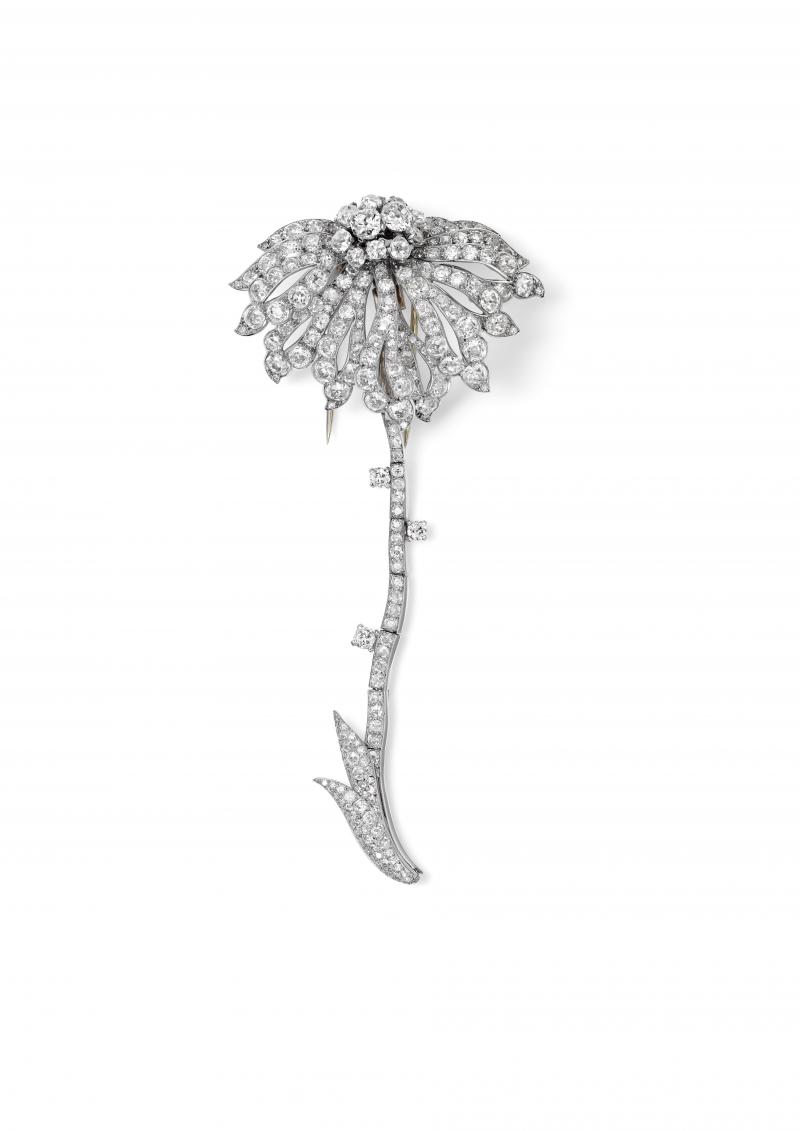
Flower clip brooch.
Cartier Paris, special order, 1941 Platinum, gold Diamonds. Cartier Collection Nils Herrmann, Cartier Collection © Cartier

Two Fern spray brooches.
Cartier Paris, 1903. Platinum Diamonds Sold to Sir Ernest Cassel. Cartier Collection Nils Herrmann, Cartier Collection © Cartier

Flower clip brooch.
Cartier Paris, 1938. Gold, platinum. Diamonds Rubies Sold to a member of the Rothschild family. Cartier Collection Nils Herrmann, Cartier Collection © Cartie

Clip brooch and pair of ear clips Cartier, circa 1970.
Gold. Wood. Cartier Collection Nick Welsh, Cartier Collection © Cartier
29 March – 5 June
From the Great Mughals to the Maharajas: Jewels from the Al Thani Collection
From the Great Mughals to the Maharajas : Jewels from the Al Thani Collection is an expedition to the heartland of the Indian jewellery tradition. Showcasing more than 270 pieces from the Al Thani Collection alongside loans from institutions and private collections including the Cartier Collection, the exhibition traces a history of court jewellery, staging a dialogue between artworks and rare gems and great diamonds from the Mughal era to the present day.
The immersive layout and lighting design – a reference to the immense sophistication of Indian culture – invite the visitor on a two-part journey corresponding to the dual themes of the exhibition: the artistic sophistication of Mughal India, and exchanges between India and Europe since the Renaissance.
Cartier’s Indian-inspired creations, whether part of the Al Thani Collection or the Cartier Collection, illustrate the Maison’s panache in appropriating this influence into its stylistic identity.
Cartier has loaned three major pieces from its Collection to the exhibition. The Maharaja of Patiala’s legendary ceremonial necklace, composed of 2,930 diamonds, weighed some 1,000 carats in its original configuration. This breathtaking piece, restored in 2002, was worn as a ceremonial set with a chocker necklace in platinum and diamonds that feature seven light yellow diamonds. This ensemble, newly reunited, will be exhibited at the Grand Palais alongside another Indian-inspired creation and icon of Cartier’s Tutti Frutti jewels : the Hindu necklace commissioned by Daisy Fellowes. The necklace is generously laden with carved rubies, sapphires and emeralds and is a feminine and amboyant gauge of the extent of Indian influence on the creative accomplishments of the Maison.
The exhibition will also present other Cartier jewels, both antique and contemporary, including the turban ornament created in 1937 for the Maharaja of Nawanagar with the famous tobacco-coloured Tiger Eye diamond of 61,50 carats, as its centrepiece.
The Cartier Collection is honoured to be part of an exhibition that has travelled to the Metropolitan Museum of Art in New York, the Victoria & Albert Museum in London, and the Miho Museum in Japan.
A proud patron of the exhibition, Cartier values the Collector’s expert knowledge and desire to share his collection.
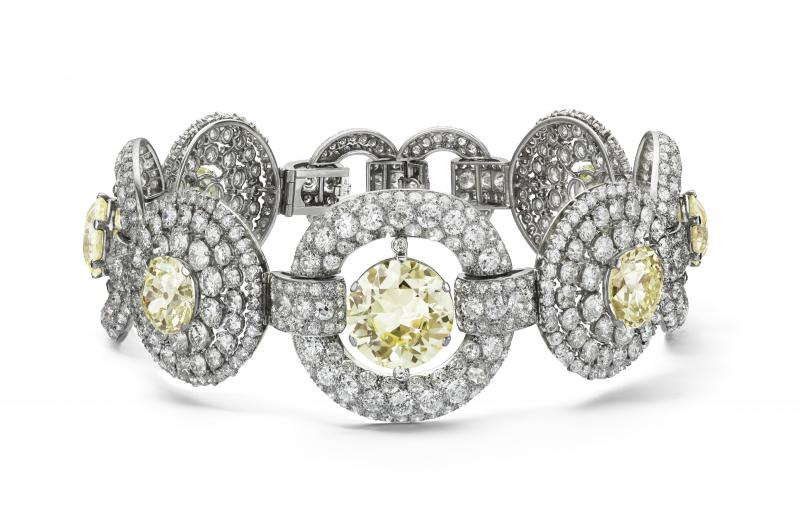
Choker necklace.
Cartier Paris, special order, 1928. Platinum. Diamonds, including seven light yellow cushion-shaped and round-shaped diamonds, weighing 76.55 carats. Created for Sir Bhupindra Singh, Maharaja of Patiala. Cartier Collection. Marian Gérard, Cartier Collection © Cartier
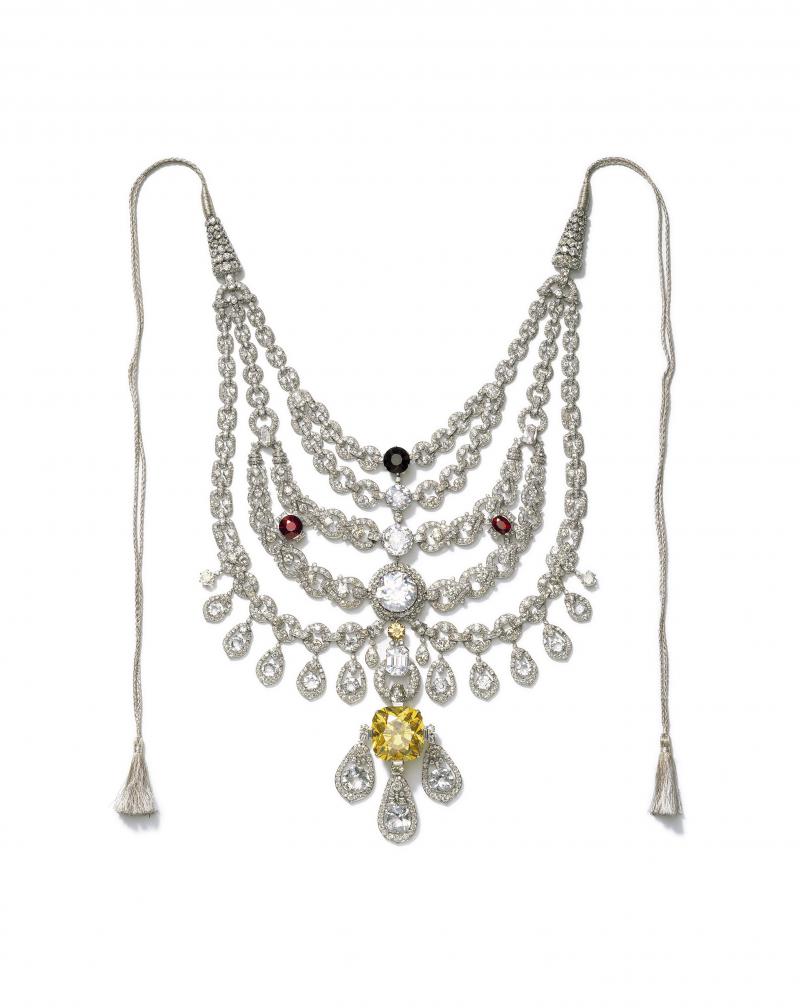
Necklace.
Cartier Paris, special order, 1928. Platinum Diamonds Zirconia Topazes Synthetic rubies Smoky quartz Citrine.Created for Sir Bhupindra Singh, Maharaja of Patiala.
In 1925 the fabulously wealthy Sir Bhupindra Singh, Maharaja of Patiala, entrusted Cartier with his gems to modernise his traditional Indian jewels in a more Western fashion.Three years later, the new jewels were exhibited at the rue de la Paix in 1928, and in particular
a magnificent ceremonial necklace mounted on platinum. Composed of no fewer than 2,930 diamonds and two rubies, the necklace had at its centre the De Beers diamond, a yellow stone of 234.65 carats, making it the seventh-largest diamond in the world at the time.
The necklace vanished after Indian independence in 1947. In 1998, Éric Nussbaum, the former director of the Cartier Collection, discovered it in a poor state . The restoration was to take Cartier’s artisans over two years. After various efforts, it was decided to use substitution stones that would match the brilliance of the original ones. Zirconia and white topazes were used to replace the diamonds, whereas synthetic rubies took the place of the natural rubies. Further work was done on the platinum chain necklaces, specifically the reconstitution of the pendant that held the De Beers diamond. The restoration task was thus one of honouring the original craftsmanship of the necklace. The necklace, as it now appears in the Collection, was shown in public for the first time in 2002.
Cartier Collection. Nick Welsh, Cartier Collection © Cartier
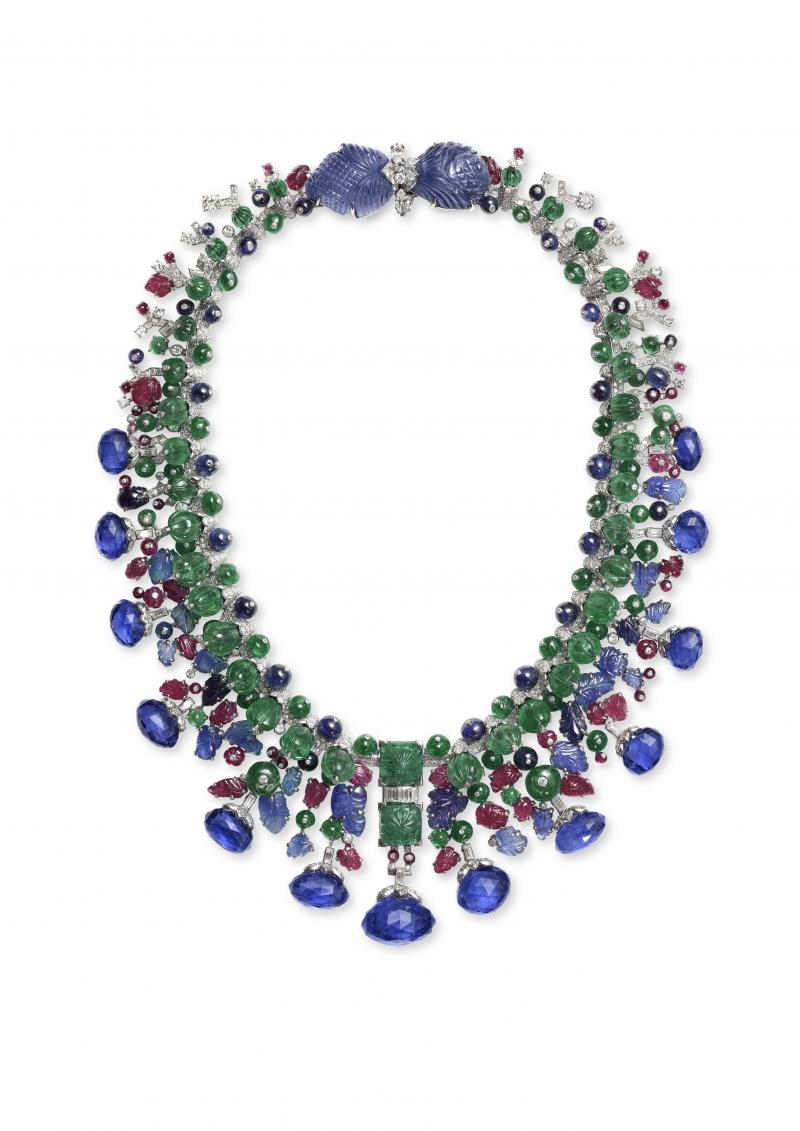
Hindu necklace
Cartier Paris, special order, 1936, altered in 1963. Platinum, gold, diamonds sapphires, emeralds, rubies. Made as a special order for Mrs. Daisy Fellowes. Cartier Collection Nils Herrmann, Cartier Collection © Cartier

The Taj Mahal Emerald.
India, 1650-1700. Weight: 141.1 carats. Al Thani collection. All rights reserved. Photo Prudence Cuming.

The Nawanagar Ruby Necklace.
Cartier, 1937. Platinum, rubies, diamonds. Al Thani collection © Christie’s Images Ltd
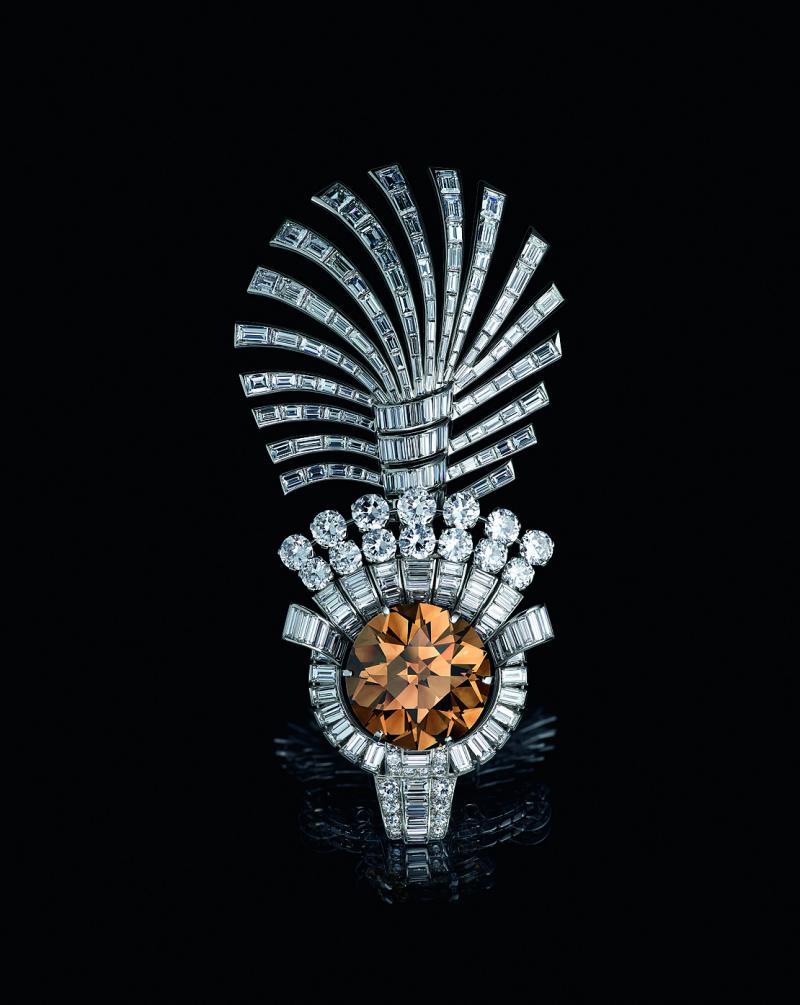
The Tiger Eye Turban Ornament.
Cartier, 1937. Platinum, diamonds, including the Tiger Eye diamond weighing 61.50 carats. Thani collection. All rights reserved. Photo Prudence Cuming
No Comments